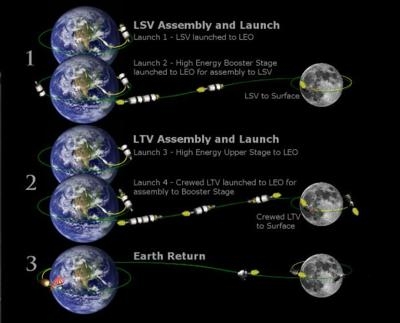Fri, Oct 18, 2013
Rima Marius Sees Ongoing Human Presence On The Moon
A private group founded by entrepreneur Joel Ammons says it just does not want to send humans back to the Moon, "we want to go and then keep going, again and again and again."

The company is Rima Marius, which says in its website that it is named for the region of the Moon that is its objective. The company says it was formed as a for-profit entity "focused on developing both technically and financially sustainable systems that will not only provide for an initial exploration of the Marius Hills region, but a continuing, comprehensive exploration program."
Rima Marius says the project is vast in its scope, allowing for the use of both existing and near-term technologies to ensure success. Such technologies as 3D Printing already exist, and will be used for the construction of a moon habitat. Several trips will have to be performed to establish the project on the lunar surface, and make ready for the crewed follow-up mission.
The company says on its website that the expedition requires two spacecraft, launched approximately 4 months apart:
- A Lunar Surface Vehicle (LSV), which would be the first vehicle dispatched to the moon and would be injected into a 90-day Weak Stability Boundary (WSB) transfer. This vehicle will deliver the housing components to be constructed for the astronauts to use for the duration of their surface stay; and
- A Lunar Transfer Vehicle (LTV), which will carry the crew to and from the lunar surface on 3-day transfers.
Each of these spacecraft is launched and assembled in components, delivered separately to low-Earth orbit using SpaceX Falcon Heavy launch vehicles. For the LSV, the first launch delivers a lunar lander/descent stage and the housing construction components to be stocked with enough supplies and provisions to support two 4-person expeditions for 150 days each.
The crewed mission is scheduled to last 75-days, and will include exploration of lunar "Lava Tubes", and the Marius "Pit", a deep hole that may be the entry point into a collapsed lava tube. This target may be a suitable area for a long-term moon base. The cost of the mission could equal $2.5 billion, and will be raised through efforts like the newly created STAR Fund for private investors, and also through crowd-funding.
(Mission plan image provided by Rima Marius)
More News
Aviation Governance Secured...At Least For a While The National Business Aviation Association similarly applauded the passage of the FAA's recent reauthorization, contentedly recou>[...]
Emphasis On Growing The Future of Aviation Through Concentration on 'AFFORDABLE FLYERS' It's been a number of years since the Latest Edition of Jim Campbell's HUGE SportPlane Resou>[...]
Amazilia Aerospace GmbH, Develops Digital Flight Control, Flight Guidance And Vehicle Management Systems Textron eAviation has acquired substantially all the assets of Amazilia Aer>[...]
Honeywell's Primus Brings New Tools and Niceties for Hawker Operators Hawker 4000 business jet operators have a new installation on the table, now that the FAA has granted an STC f>[...]
Company Celebrates Niche-but-Important Advancement in Industry Standards Echodyne has announced full integration of its proprietary 'EchoFlight' radar into the e American Aerospace>[...]
 Bolen Gives Congress a Rare Thumbs-Up
Bolen Gives Congress a Rare Thumbs-Up The SportPlane Resource Guide RETURNS!!!!
The SportPlane Resource Guide RETURNS!!!! Buying Sprees Continue: Textron eAviation Takes On Amazilia Aerospace
Buying Sprees Continue: Textron eAviation Takes On Amazilia Aerospace Hawker 4000 Bizjets Gain Nav System, Data Link STC
Hawker 4000 Bizjets Gain Nav System, Data Link STC Echodyne Gets BVLOS Waiver for AiRanger Aircraft
Echodyne Gets BVLOS Waiver for AiRanger Aircraft



